Ever wish you had a tiny helper on your shoulder during the workday? Someone who could draft your emails, handle quick administrative tasks, or perhaps respond to your unread Slack direct messages (DMs) on your behalf?
We don’t have a tiny magic helper to save you time during your workday, but Slackbot is an automation tool that can add a sprinkle of magic to your day. With Slackbot, you can create custom responses to save your team time, seamlessly share information, and make your teammates smile.
In this quick guide, we’ll explain:
- What Slackbot is
- How to create Slackbot custom responses (with examples)
- Tips for preventing notification madness
What is Slackbot?
Slackbot is a friendly chatbot designed to welcome users into the Slack app, send reminders, answer product questions, and pop in with other updates. All members and guests on all plans can use Slackbot.
Here’s a closer look at what Slackbot can do:
- Send reminders in Slack channels and DMs
- Notify users when someone else mentions them in a Slack channel they aren’t part of
- Let members know when someone archives a Slack channel
- Send customer responses
If you’re a Slack user, you’ve likely come into contact with Slackbot.
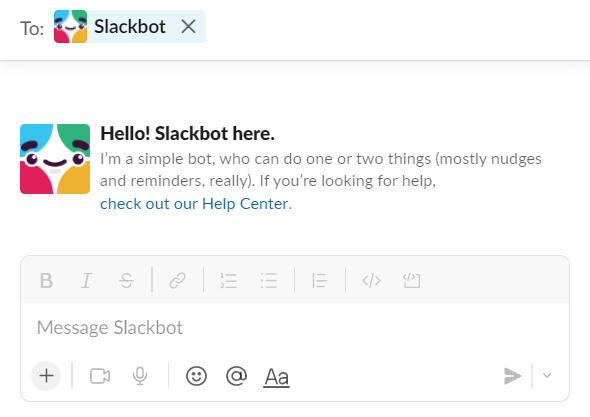
What to know about custom responses with Slackbot
A neat thing about Slackbot is that you can configure it to provide customized, automatic responses when someone uses a specific word or phrase in a post. With custom responses, you and your team can mold your Slack workspace into a digital environment that’s unique to your team. We’ll walk you through how to set up custom responses, but first, there are a couple of things you need to know.
Owners and admins can manage Slackbot response settings.
In Settings & Permissions, an owner or administrator can enable or disable Slackbot responses and set who can manage Slackbot responses. If an owner or administrator enables this setting, they can select “Everyone (default)” or “Workspace Owner and Admin Only” as the people who can manage Slackbot responses for the workspace.
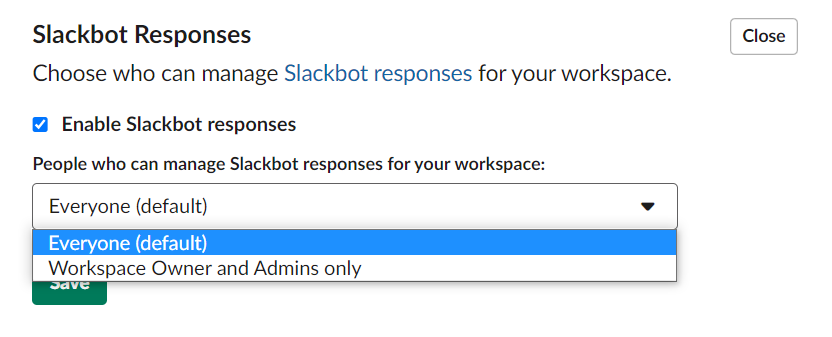
It’s not possible to turn off all Slackbot notifications.
Before setting up your custom responses, it’s essential to know that users can’t turn off all notifications from Slackbot. Keep this in mind when considering what you want to use the customer responses for and how they might impact the team. (And more on notifications later!)

Image source: Slack Help Center
Setting up custom responses with Slackbot
Here’s what you need to do step-by-step to set up custom responses in your Slack workspace.
Step 1: Open your Workspace menu and navigate to the Customize Your Workspace page.
Using the menu in the upper lefthand corner of the app, select “File,” then “Settings & Administration,” and “Customize {name} Workspace.”
Or, if you’re using your browser, navigate to https:/{insert name of workspace}.slack.com/customize/slackbot.
You should end up on this page:

Step 2: Click the “+ Add New Response” button and set your criteria.
When adding your response, the Slack pop-up box will prompt you to enter the trigger for the response or what someone says that will prompt the automatic reply. Below it, you will need to enter what you want Slackbot’s response to the trigger to be.
Slackbot can respond with text, phrases, emojis, or GIPHY links.
You can input multiple options in both boxes. Separate input phrases with a comma so Slackbot knows exactly what to look for. If you add multiple Slackbot responses, be sure to enter each response on a new line. Note that if you enter multiple Slackbot responses, the bot will generate them randomly when prompted.
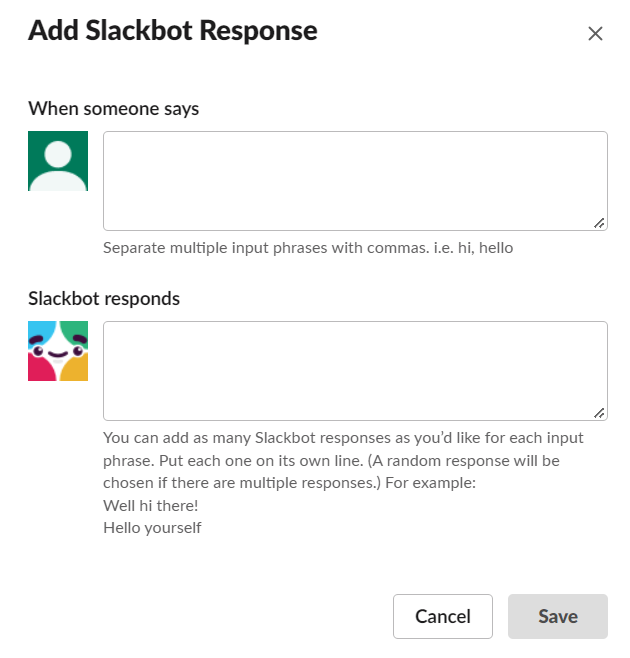
Step 3: Save the response.
Press “Save,” and Slackbot is ready to serve as your tiny helper, responding to your team quickly, so you don’t have to! It’s that easy.
Examples of Slackbot responses
Even if you’re tremendously organized and can find information quickly, or you’re a freaky fast typer and can respond rapidly, custom Slackbot responses will save you time and space on your to-do list. Slack can do part of your work for you when you leverage custom responses. Custom responses work best to provide information and guidance without causing overwhelm from firing too often.
Not sure how to make the most of Slackbot responses? You can find some examples in the Slack guide to custom responses and on the Technipages blog. Read on for three of my favorite use cases.
Share the office Wi-Fi password
The hybrid and remote work era enables employees to pop into the office on occasion sporadically. Infrequent visits might make it challenging to recall the Wi-FI password and use the office connection for the day. You can use Slackbot to send the Wi-Fi password to current employees and new hires when needed.

Celebrate your team’s wins
A little bit of recognition goes a long way, and Slackbot can piggyback on the team’s compliments to each other. Spruce up your conversations with a fun GIF for an extra celebration!
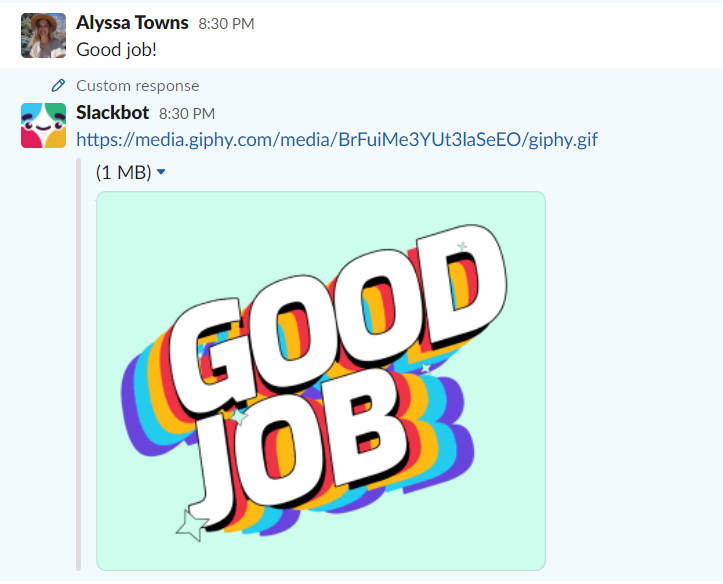
Send standard reference documents
Do you and your team use documents that you’re always trying to locate and track down? Maybe it’s an editorial calendar, a project tracker, or your company’s brand guidelines. Whatever the case, you can set up a Slackbot response to send links to documents so team members don’t have to sift through files and waste time trying to locate them.

When creating custom responses for documents, consider whether other company documents share a similar name. For example, maybe the Marketing team has their own editorial calendar specific to their team workflows, and there’s a company editorial calendar spotlighting all upcoming blog posts. Be specific when setting up your custom response to prevent confusion.
Promote more inclusive language
One Slackbot custom response appears in Slack’s guide to custom responses and it emphasizes giving people a nudge when using exclusive language or phrases. Slack references digital services agency 18F, and how they use Slackbot to send custom responses around using more inclusive language to avoid alienating anyone.
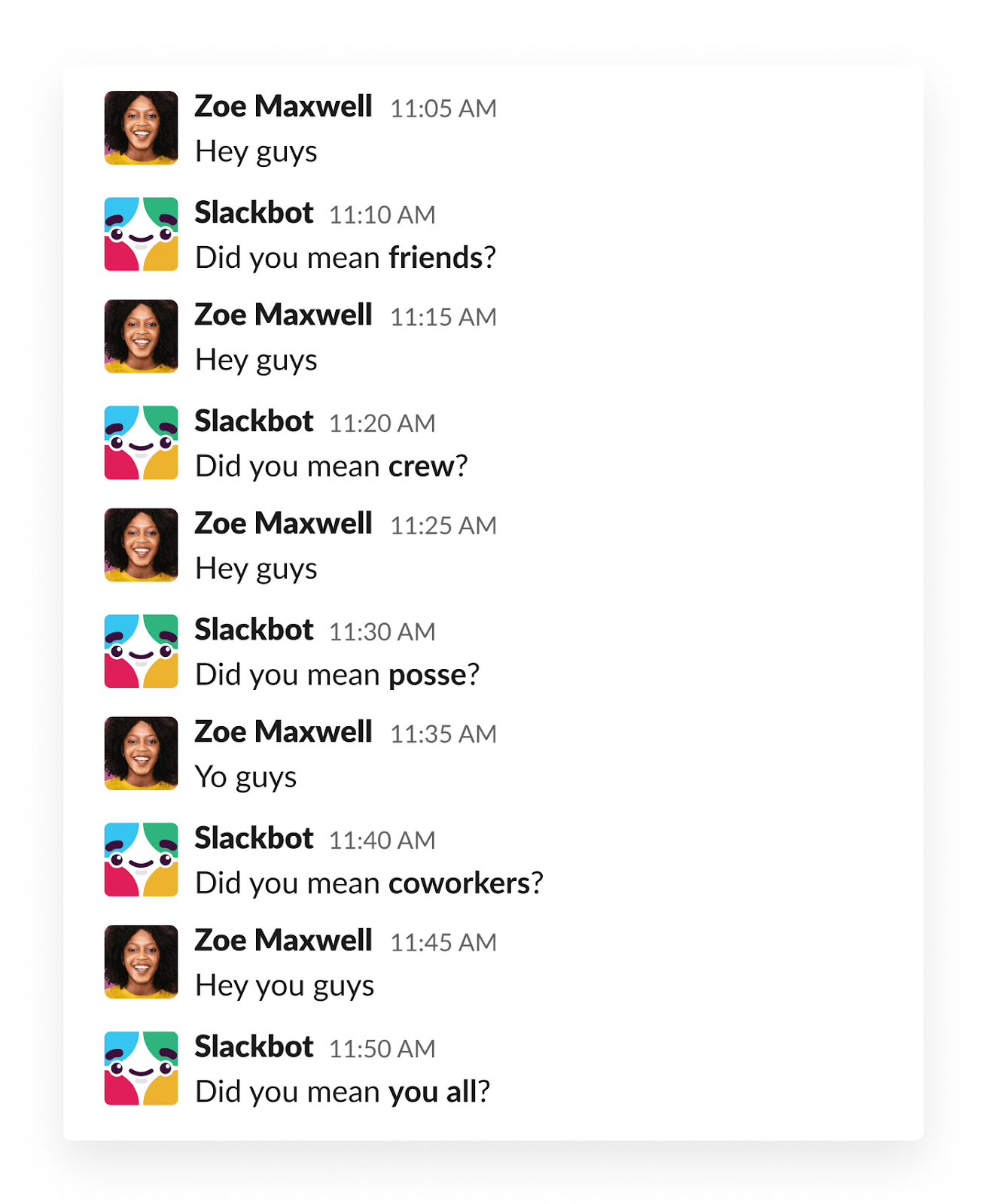
Image source: Slack
A word on notification madness
Remember, it’s not possible to turn off all notifications from Slack. And while custom responses can be a valuable automated resource, if Slackbot sends too many notifications, it can become more of a burden than a help.
To prevent notifications from disturbing your teammates, you should avoid using common, generic terms and phrases as your inputs. You need to understand how your team communicates on a regular basis to create the most meaningful (yet not distracting) custom responses. For example, the word “code” could trigger too many notifications for a software development team constantly communicating about code changes.
Although you can’t mute all notifications from Slackbot, if you’re feeling overwhelmed by your Slack app, try muting Slack channels or turning notifications off to reduce the amount of overall noise.
Set up Slackbot custom responses today
Slackbot is the tiny helper that can respond to some of your Slack messages for you on your behalf. You can configure custom responses to save your team time, seamlessly share information, and make your teammates smile. Set up Slackbot custom responses in three easy steps to do things like automatically share the Wi-Fi password with colleagues, virtually celebrate good work, and share links to reference documents and materials. Keep the number of notifications Slackbot triggers top of mind to avoid overwhelming teams.


.gif)



